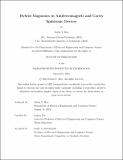| dc.description.abstract | Hybrid dynamic systems combine advantages from different subsystems for realizing information processing tasks in both classical and quantum domains. Magnons, the collective spin wave excitations in magnetically ordered materials, have recently attracted great attention for realizing hybrid dynamic systems. In this thesis, we develop hybrid magnonic systems with reduced complexity, improved scalability, and new functionality. In the first work, by utilizing van der Waals antiferromagnetic material CrCl3, we realize strong magnonmagnon coupling within a single material, simplifying the design of magnon-magnon hybrid systems which conventionally require two magnetic materials. Secondly, by utilizing planar microwave resonators, we realize on-chip, lithographically scalable, and Circuit Quantum Electrodynamics compatible magnon-photon hybrid systems. Strong magnon-photon coupling with three orders of magnitude reduction in spin number is demonstrated due to the reduced effective cavity mode volume. Moreover, the on-chip design, featuring substantial coupling strength, enables the integration of spintronic techniques to control the magnon subsystem dynamics via electrical currents. Along this line, in the third work, we theoretically propose a novel microwave oscillator device: a spin-torque-oscillator maser, which combines a spin-torque oscillator with a resonant cavity. This device aims to overcome the limitations of area, power, and linewidth inherent to traditional spin-torque nano-oscillator devices. In the fourth work, we experimentally realize a tunable magnon-photon hybrid system that leverages the spin-torque effect to electrically modulate magnon dissipation. We observe distinct linewidth modulation effects in systems with different cooperativities. Finally, we suggest methods to enhance the efficiency of magnon dissipation tuning while reducing power consumption, thereby laying groundwork for the development of spin-torque-oscillator masers. This thesis work serves as a foundation for future advancement of hybrid magnonic systems, highlighting their potential for both fundamental research and practical device applications. | |
